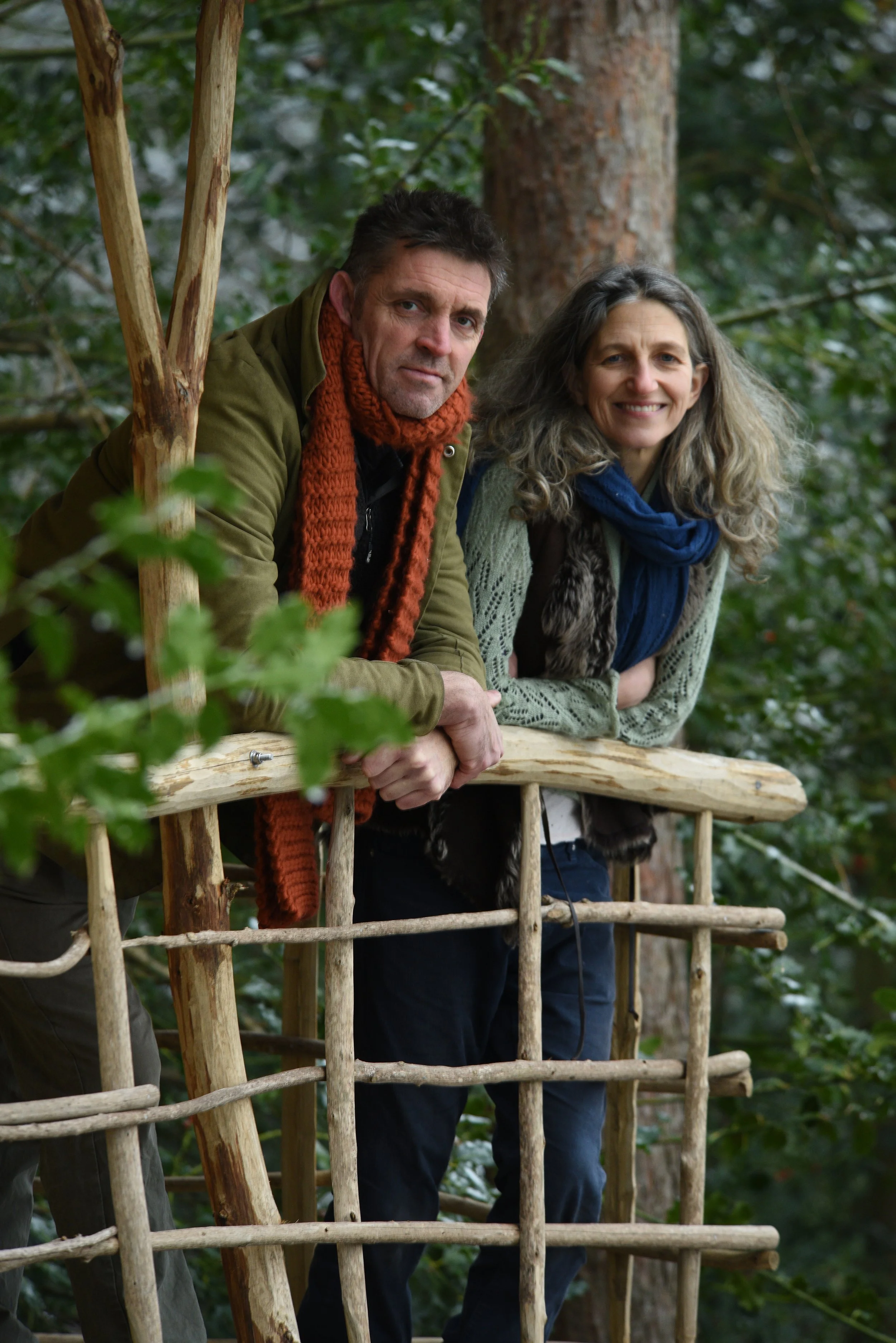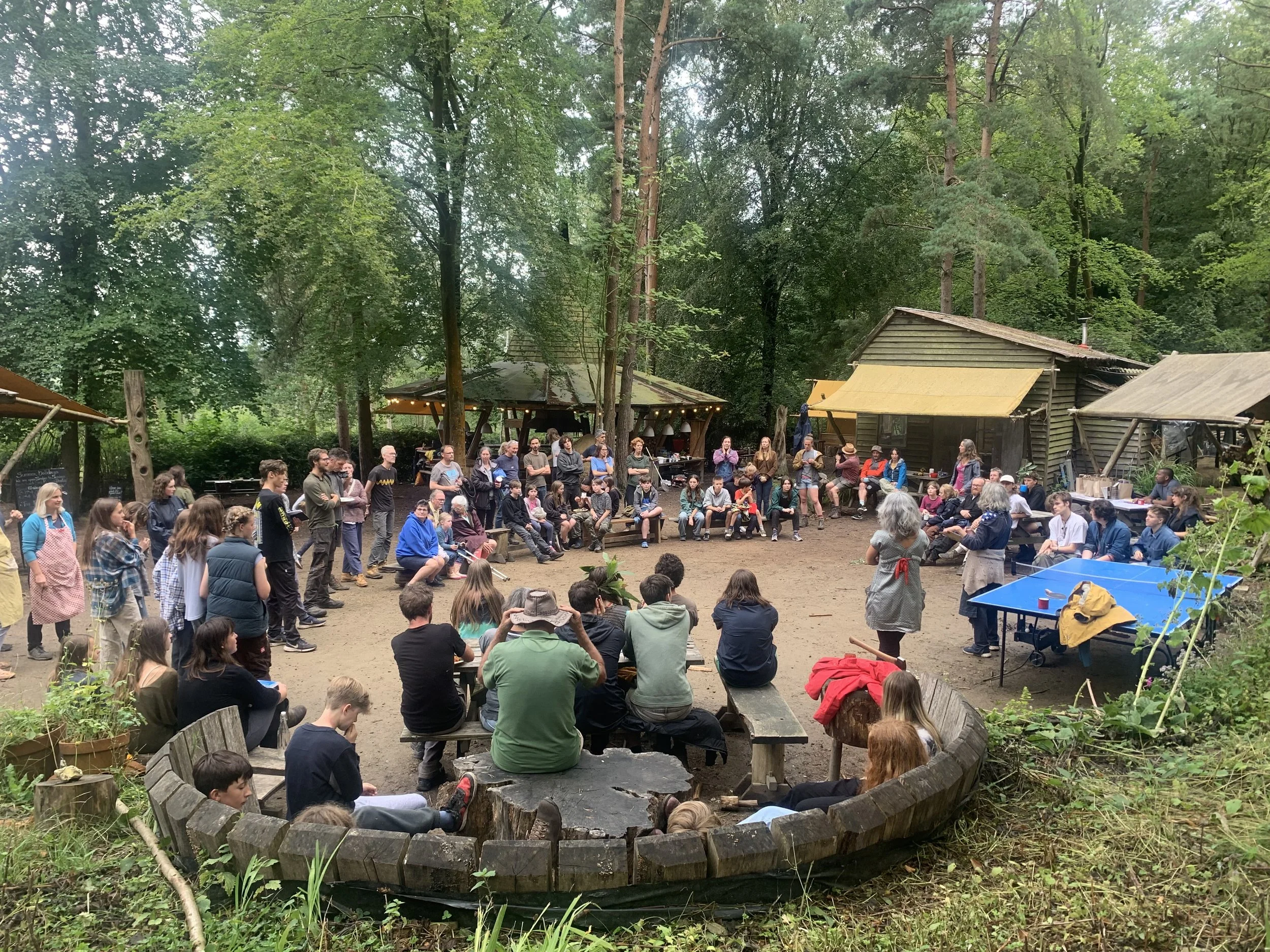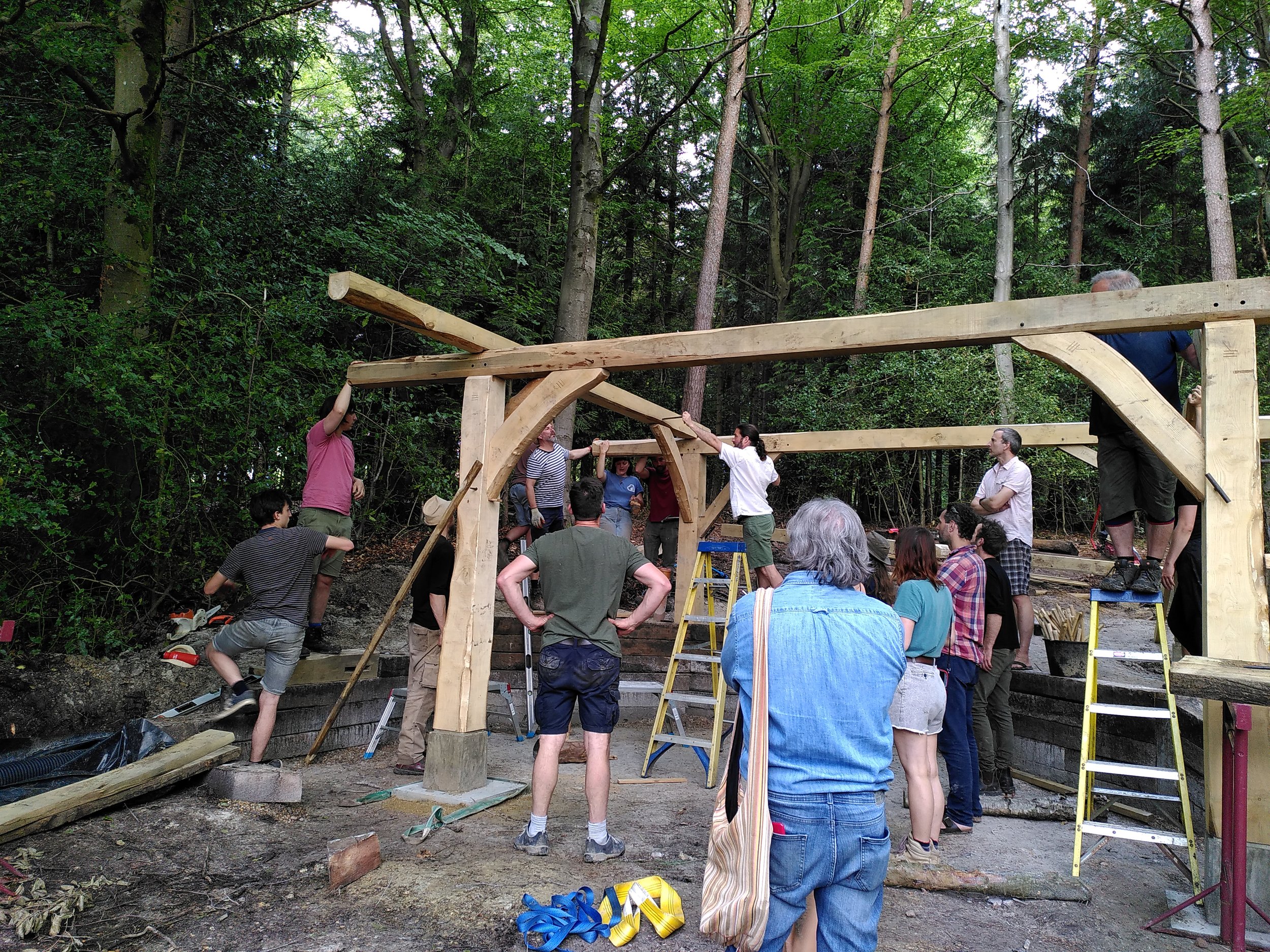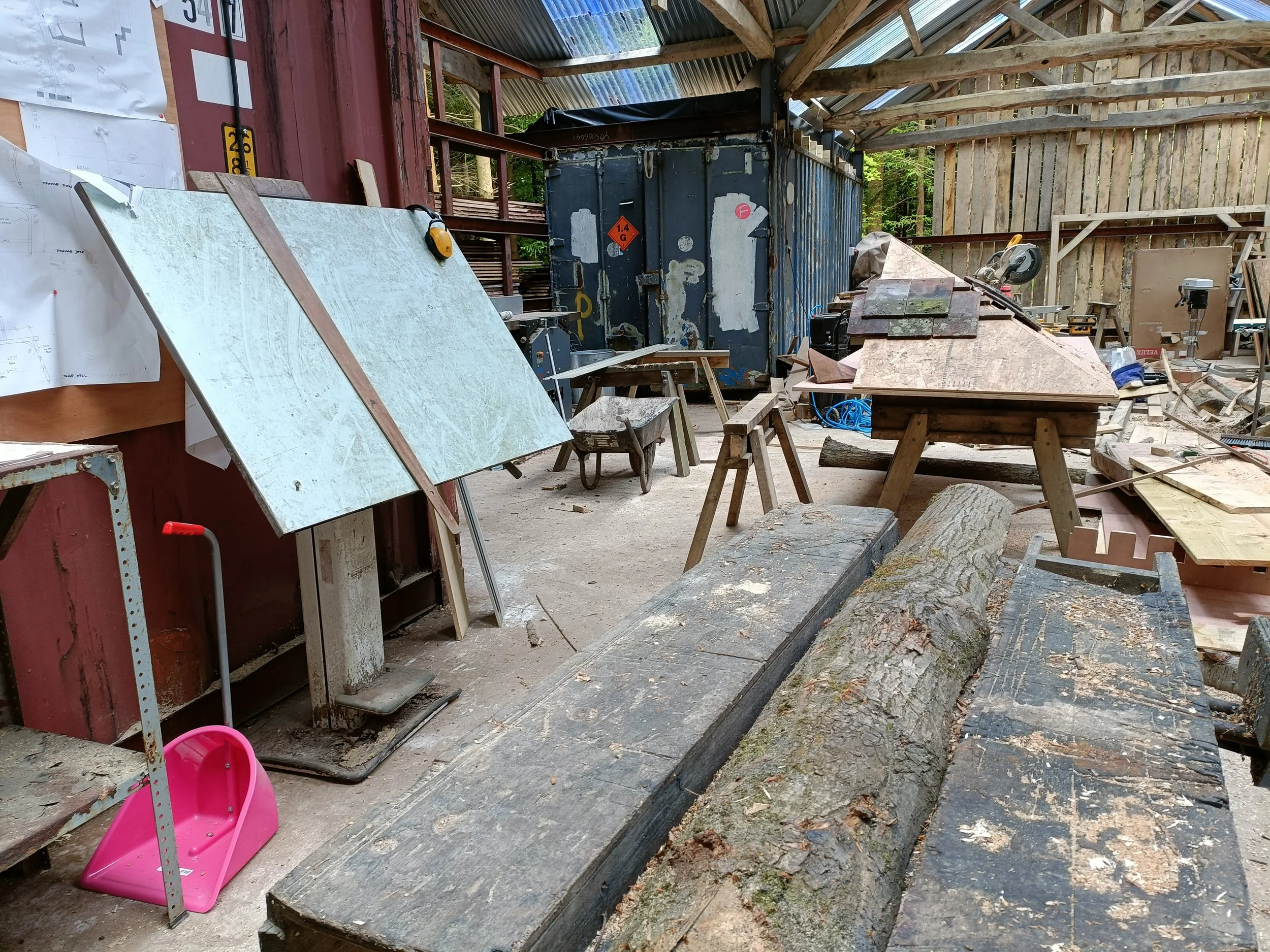Interview with Dan Morrish - Wilderness Woods
Located in the Sussex Weald, Wilderness Wood is billed as “An ancient woodland where adults and children work and play.” While it is indeed all of those things, there’s one very important word missing from the description: magical.
On entering the 60 acre community woodland during a research trip as part of my recent residency with CAUKIN Studio, I was immediately struck by the sound of birdsong, smell of saw dust and sight of numerous intriguingly designed timber structures. A publicly open space, it is also home to founders Dan and Emily Morrish, along with their family - bio and chosen - all of which work on-site in some capacity. Currently celebrating their 10th anniversary, I was immediately intrigued to find how such an environment came about and operates, and found my interest further piqued in discovering that Dan had been a practising architect before becoming a full-time woodsman.
Architecture is a profession that he remembers telling his mother he would like to join when he was five years old. Although having graduated in the mid-nineties during a, “real slump in the construction industry,” which also coincided with a shift to on-screen designing, some seeds of doubt began to germinate. Having moved to Hong Kong with a number of his peers to find work with Tonkin Liu, he later settled in London. There he first worked for Keith Tillman before then setting up a design and build practice with friends from The Bartlett School of Architecture, until eventually going it alone. Having built a portfolio of retail and high-end residential projects he found his enthusiasm for the process waiver, and having had children, both he and Emily felt another calling. Emily’s own career in education was raising big questions in them both about what the best conditions for people to learn most favourably in might be, and it was here that the seed of the community woodland grew.
Over those 10 years it has continued to flourish into a magical, wild, wonderland and it was my pleasure to sit down with Dan to go into more detail about how it all started and what drives him and the team on day-to-day.
JB: I’m blown away by what you’ve built here and there is palpable vitality to the place from the moment you enter. So I’m very intrigued to hear more about how you went from a career in architecture to running a community woodland packed full of incredible timber structures and buildings.
DM: Well, I’ve realised that what makes these stories much more appealing is if you pretend that there’s some distinct narrative arc that drew you through it, but actually, I’d have to say there wasn’t for me. It makes more sense looking back now, but you have to allow yourself to go down a few dark alleys. I tell this to my kids all the time; if you have no bandwidth and permission to make mistakes, your life path will be aridly dry. So mistakes are key, and maybe if you tell the story in great detail you can see how the mistakes are in effect the plotline.
I think my aspirations were fairly ordinary. I decided I wanted to be an architect, went to college, had moments of inspiration from brilliant people interspersed with lots of questioning what I was doing, and at times wondered what the route might be for me. On the one hand, it’s a positive that it’s a protected title, with a professional code of conduct, but it does mean there are gatekeepers and there does appear to be a sausage machine that you are squirted through in order to do what the modern world calls indemnifiable practice as a professional - and into the machine you go.
JB: So was it simply that you’d had enough of the industry? Or did you never quite connect with the system you’d found yourself in?
DM: Architecture as an industry is in a moment of crisis - just look at the mental health issues of overworked staff, the shocking pay structure and the appalling so-called ‘Starchitect’ vs the ‘nobodys’. It feels like a system that people are increasingly realising isn’t working. You could say the same for the economic system we find ourselves in too, and they are arguably deeply entwined anyway.
I was the generation that experienced the arrival of the computer in the office, but I am one of life's computer dunces. I’m just so resistant to them; I don’t want to have to rely on them. Don’t get me wrong, I’ve seen others flourish with them, but I just couldn’t do it…and I hated them. Roll on 30 years and of course computers have turned out to be on the right side of history, but that meant all the drawing boards got thrown out of practices almost overnight, and now everyone sits at a screen. Personally, I think that’s killing a significant part of humanity, because it’s a machine, and even if you’re that way inclined, the human sides of you are being undernourished. Does it allow you to be cross-disciplinary and creative? Does it bring in other people? These are all really vibrant and important things.
JB: And so, 10 years ago, you and your wife Emily decided to buy a working woodland! It feels like such a uniquely brave thing to do. Although as you mentioned, other people have always played a vital role in the process. And while you co-habit with the Reed family now, am I right in thinking that you initially intended to set up the space with others?
DM: We started talking about the idea with friends in London over 10 years ago. I thought I needed the collective element to take the leap. But having discussed how we might approach it, and having got close to investing in a place, life always seemed to get in the way and the others couldn’t commit at that moment. So we finally decided that we would just have to do it on our own - and I panicked. I was sure I couldn't do it on my own, and came up with lots of potential problems, but one day my younger cousin said to me to stop worrying and get on with it. And she was right - build it and they’ll come! What I now understand is that you can’t choose or control everything about how you want to do something, but you have to put a couple of key markers in place and go from there. You create a space in which life can flow into, and that’s the bit that you can’t see at the start - you can’t fully know what shape or form it will ultimately take.
JB: That sense of autonomy must be incredibly liberating, not least when you are able to compare your own construction processes with your previous experiences of the architecture industry. Given this is a woodland, I imagine that your material also offers an extra layer of freedom and flexibility too?
DM: I was always looking for another way of doing things. Now it’s unbelievably clear: the corporate world is roaring off a cliff and they’re seemingly not going to stop, and while for some reason people seem to think that technology is going to save us, I don’t think it’s the answer, I don’t want to be a part of it. I also think I and many others can now say with some pride, and urgency, that we’re not happy to contribute to something that others are suggesting will be the big-picture solution. I want to find another route, and it’s really exciting to meet others like me.
I never felt comfortable with steel and concrete and all the embedded carbon; and now realise I always wanted to work with wood…although if I’m honest, I never really knew why that was. 10 years later, I now know that it was a brilliant idea! It grows, it’s cyclical, but it also needs looking after - which is a lovely thing. But timber framing as a medium has taught me so much - and really helped to decouple from some of the shackles of architecture. That’s because it imposes this traditional art form - and I can lean on the wisdom of some amazing people in my team - while we also have the luxury of this amazing material called wood, which is just a part of the overarching story here. It takes away the fear of the blank canvas and offers us some clear parameters to work with - which is a good thing. It means we can hone our skills while going even deeper with it. That’s one of the happy, ideological marriages; this is a semi-anarchic, resilient community woodland and a place where you build with material that if you need more, you just grow more. And that’s powerful.
JB: I guess having such a sustainable resource is also fairly forgiving in that it also allows for those all-important mistakes that you’ve already touched upon…and I’m aware from your son Frank’s humorous appraisal of all the buildings here in the most recent Wild Times zine that you’ve had to physically move a number of them post-build.
DM: Architects are trained to believe that a rigorous design and procurement process means that you have everything in place and you don’t do the expensive thing of commissioning anyone to move anything around in reality until you’ve totalled nailed the plan - it’s what contract means, really. But I think that kills the process from the very beginning, and it also gives you a nagging feeling that you need to have everything sorted right from the start. My role here is that of the master builder, which ultimately means working with craftspeople who know the material and can respond to challenges as we go along. That means we don’t always have to have a rigid plan in place and can be responsive to the process, and one another. Design processes might be iterative on paper, but it seperates the physical construction process, which can also be iterative. The great privilege we have here is that we can do both, and most importantly allow ourselves permission to make a few mistakes; which in turn allows for reinterpretation and having another go. You find stuff out by doing it.
Viability is always the challenge, but there’s a conviction that it’s the right challenge. We’re trying to get together and do things that looks after us in all the ways it needs to look after people - not, “Is this a bulletproof business plan?” or “Are we paying returns to investors.”
JB: Although it is still a business, and one of the ways you make money is from people visiting the woods. How do you balance all of the construction projects with providing a service for your guests?
DM: It’s a family place really, certainly at the weekend anyway, and we have to meet the great British public and in some sense give them what they want. Admission is for the wood, of which there are 60 acres, and off you go. Some people know what they want to do with that, like going for a nice walk. But then we live here and are running various projects from here, so there’s also a whole programme of working parties that we’re putting on. They’re open to members, which extends our reach, but we tend to find that participants get a lot out of them and come back. Increasingly, we also tend to end up working with them in some way, with many becoming significant contributors and partners to the space. That feels very different to something that’s happening in a setting that’s open to the general public. Ultimately there’s a tiering of the home team, which consists of 10-15 people; members, which total around 150 families; participants attached to the projects and events we might be doing, and the general public. What’s funny is that in a way, we didn’t see that coming. We looked at 150 plots of woodland all over the country and the continent, but the majority of them were extremely remote and/or in areas of economic difficulty. When we found a piece of woodland an hour from London - which don’t come up very often - we worried about the price tag, but the ultimate dividend is that there are lots of people in fairly close proximity. As such, we don’t have to shout very loud for people to turn up and get involved - and it’s nice that they can enjoy and contribute towards it.
This article was first published by Design Insider.








